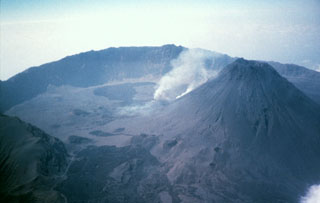Report on Fogo (Cabo Verde) — 17 December-23 December 2014
Smithsonian Institution / US Geological Survey
Weekly Volcanic Activity Report, 17 December-23 December 2014
Managing Editor: Sally Sennert.
Please cite this report as:
Global Volcanism Program, 2014. Report on Fogo (Cabo Verde) (Sennert, S, ed.). Weekly Volcanic Activity Report, 17 December-23 December 2014. Smithsonian Institution and US Geological Survey.
Fogo
Cabo Verde
14.95°N, 24.35°W; summit elev. 2829 m
All times are local (unless otherwise noted)
According to news articles the eruption from Fogo's Pico cone inside the Cha Caldera continued during 17-23 December. On 21 December gas emissions increased and the eruption plume rose 800 m. Lava continued to erupt from the main vents. By 22 December parts of the road in Ilhéu de Losna were overtaken by lava, as well as agricultural fields, a vineyard, and about a dozen homes (one remained by 23 December).
Geological Summary. The island of Fogo consists of a single massive stratovolcano that is the most prominent of the Cape Verde Islands. The roughly circular 25-km-wide island is truncated by a large 9-km-wide caldera that is breached to the east and has a headwall 1 km high. The caldera is located asymmetrically NE of the center of the island and was formed as a result of massive lateral collapse of the older Monte Armarelo edifice. A very youthful steep-sided central cone, Pico, rises more than 1 km above the caldera floor to about 100 m above the rim. Pico, which is capped by a 500-m-wide, 150-m-deep summit crater, was apparently in almost continuous activity from the time of Portuguese settlement in 1500 CE until around 1760. Later lava flows, some from vents on the caldera floor, reached the eastern coast below the breached caldera.
Source: Fogo News

